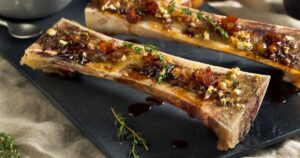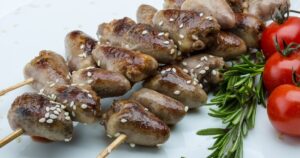Ever heard of head cheese? No, it’s not a dairy product, and yes, it’s a real thing.
This intriguing delicacy has a history as rich as its flavor, and it’s been tickling taste buds around the globe for centuries.
You see, head cheese, despite its somewhat off-putting name, is a true testament to the resourcefulness of our culinary ancestors. It’s a dish that takes what many would consider waste and transforms it into something truly delectable.
Cheese made from a head? What on earth does that taste like? Well, buckle up, my friend, because we’re about to explore its unique taste, texture, and the many ways it can be enjoyed.
How Does Head Cheese Taste?
The taste of head cheese is a delightful medley of flavors, often compared to bacon, with a tender texture that simply melts in your mouth. Depending on the seasonings and herbs used, they can be tangy, peppery, and rich.
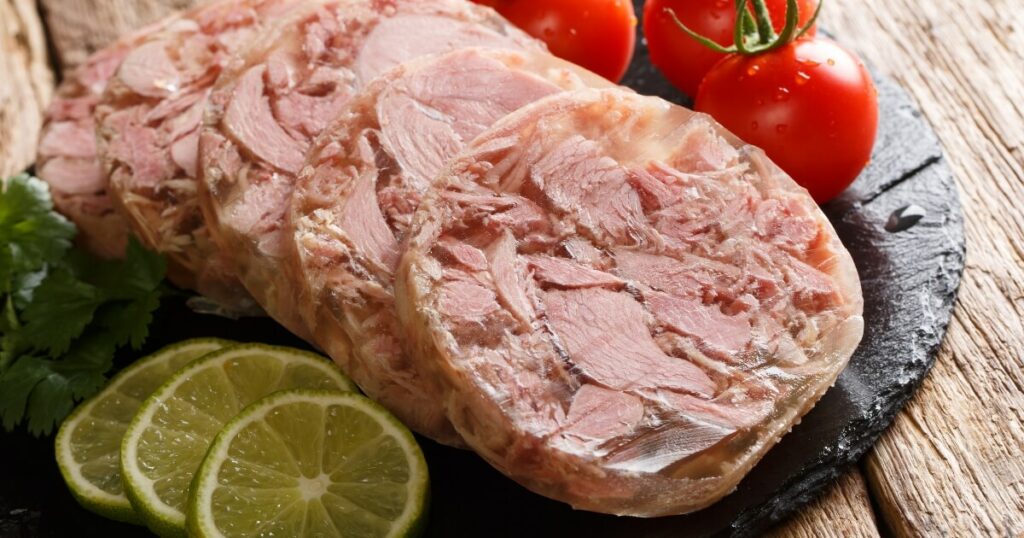
Imagine biting into a piece of bacon, that smoky, savory flavor that’s so familiar. That’s the base note of head cheese. But it doesn’t stop there.
The flavor profile is enhanced by a tangy kick, a hint of pepperiness that adds a bit of spice to the mix. It’s a complex flavor that keeps your taste buds guessing.
The texture of head cheese is just as intriguing as its taste. It’s soft and tender, almost melting in your mouth as you bite into it. This is due to the collagen from the head meat, which gives head cheese its unique, gelatinous texture.
As for the smell, it’s as appetizing as the taste. It’s a rich, meaty aroma that’s sure to make your mouth water.
However, the smell and taste can vary depending on the seasonings and herbs used. Some versions might have a more pronounced herbal aroma, while others might smell more like traditional cold cuts.
The beauty of head cheese lies in its variability. The taste can range from mildly tangy to intensely flavorful. The choice of spices, the type of meat used, and the cooking method all contribute to the final taste.
So, every bite of head cheese is a new experience.
What Does Head Cheese Compare With?
- Bacon: The base flavor of head cheese compares to bacon, with its smoky, savory notes.
- Cold Cuts: Head cheese resembles traditional cold cuts in terms of texture. It’s soft, tender, and has a melt-in-your-mouth quality.
- Pâté: If you’ve ever tried pâté or other types of offal, you might find some similarities in the rich, meaty flavor of head cheese.
- Gelatinous Foods: The texture of head cheese is gelatinous due to the collagen from the head meat. It’s similar to foods like aspic or certain types of jelly.
- Prepared Pork: Some folks say that head cheese tastes like different kinds of prepared pork in one big bite.
Does Head Cheese Taste Good?
Whether or not head cheese tastes good depends on personal preference, culinary adventurousness, and even cultural background.
If you’re not a fan of offal or if the idea of eating meat from a pig’s head makes you squeamish, then head cheese might not be for you.
The gelatinous texture, which some people find appealing, might be off-putting to others.
And while the flavor can be rich and savory, it can also be quite intense, which might not appeal to those who prefer milder tastes.
So, does head cheese taste good? Well, that’s a question only your taste buds can answer.
How To Make Head Cheese Taste Good
- Season Well: The right seasonings can greatly enhance the flavor of head cheese. Don’t be shy with herbs and spices. Try combinations of thyme, rosemary, garlic, and bay leaves for a savory kick.
- Pair it Right: Head cheese can be served with a variety of accompaniments. Try it with some crusty bread, pickles, or even some sharp cheese. The contrasting flavors can really make the taste of head cheese pop.
- Cook Slowly: The key to a good head cheese is slow cooking. This allows the flavors to and the meat to become tender and succulent.
- Chill Properly: After cooking, head cheese needs to be chilled properly to set. This improves the texture and flavors to meld together.
- Slice Thinly: When serving, slice the head cheese thinly. This makes it easier to eat and allows the flavors to be more evenly distributed.
- Serve at Room Temperature: Head cheese is best served at room temperature, like many cold cuts. This allows the full range of flavors to come through.
How To Eat Head Cheese
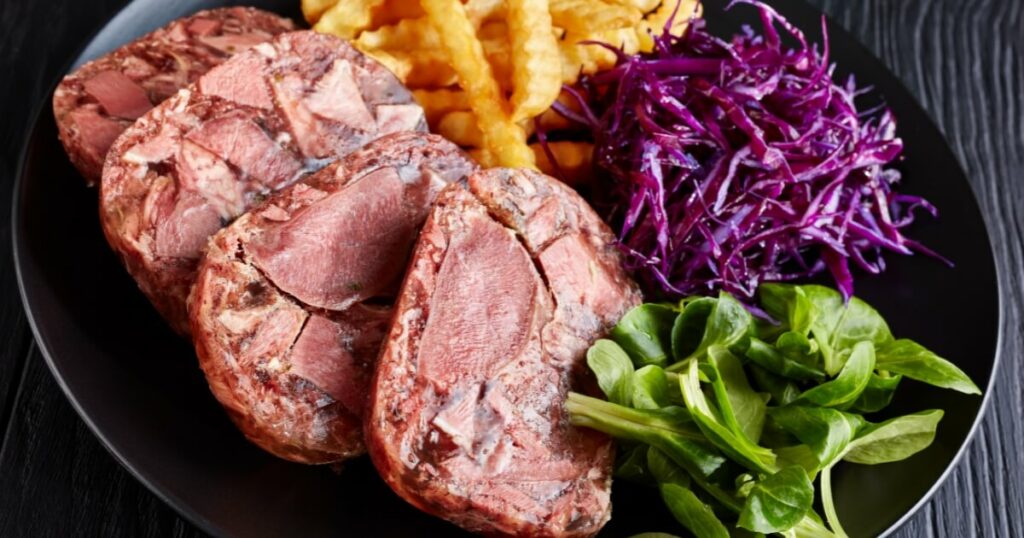
On a Charcuterie Board
One of the most popular ways to enjoy head cheese is on a charcuterie board. Head cheese’s rich, savory flavor pairs beautifully with various cheeses, fruits, and bread.
The contrasting textures and flavors make for a delightful eating experience.
In a Sandwich
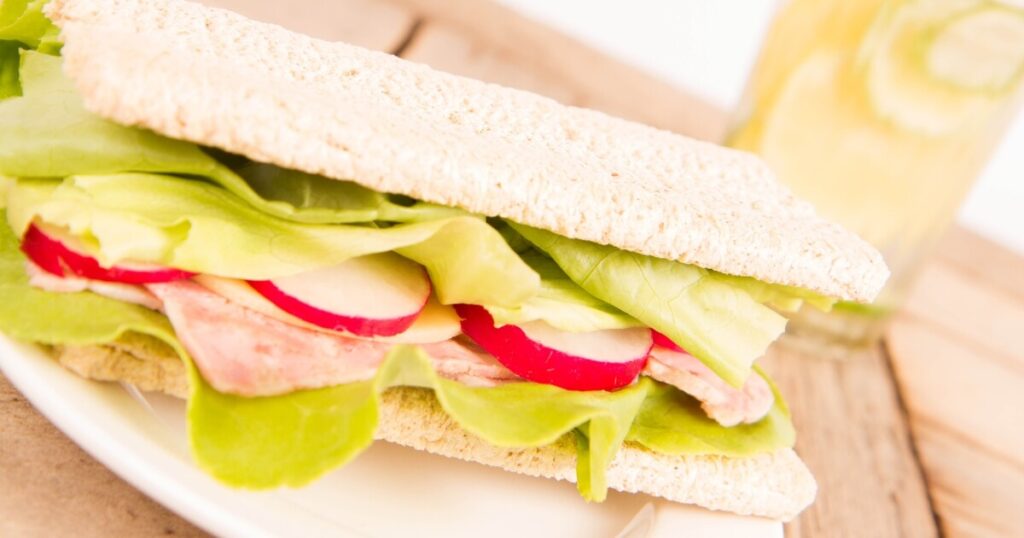
Head cheese also makes a fantastic sandwich filling. Try it with some crusty bread, sharp cheese, and a tangy pickle for a sandwich that’s packed full of flavor.
The soft, melt-in-your-mouth texture of the head cheese perfectly contrasts with the crunchy bread and pickles.
As a Snack
Try slicing some head cheese and eating it with some crackers. The savory flavor of the head cheese is a perfect match for the crisp, neutral taste of the crackers.
It’s a simple yet satisfying snack that’s perfect for any time of the day.
In a Salad
Believe it or not, head cheese can also be a great addition to salads. The rich, meaty flavor adds a new dimension to a simple salad, and the soft texture contrasts nicely with the crunch of fresh vegetables.
What Does Head Cheese Look Like?
Head cheese isn’t the most visually appealing dish. It’s essentially a collection of meat pieces from a pig’s head, which are then cooked and set into a gelatinous loaf.
The raw ingredients might be a bit off-putting to some, but remember, it’s all part of the process.
Once cooked and set, head cheese takes on a completely different appearance. It forms into a loaf or a terrine, with the meat pieces suspended in a clear, gelatinous matrix.
The color varies depending on the specific meats used, but it’s generally a mix of light and dark meat tones interspersed with translucent gelatin.

The texture of head cheese is soft and tender, almost melting in your mouth as you bite into it. But it also has a bit of a chew, thanks to the meat pieces. It’s a fascinating contrast that adds to the overall eating experience.
When sliced, head cheese reveals a beautiful mosaic of meat pieces, each with its own color and texture. The slices are usually thin and are often served chilled or at room temperature.
So, while head cheese might not win any beauty contests, its unique appearance is part of its charm.
And once you get past the initial surprise, you might find that its unusual look adds to the overall culinary adventure that is head cheese.
Different Types Of Head Cheese
- Traditional Head Cheese is the most common type, made from a pig’s head. It has a rich, meaty flavor and a soft, gelatinous texture. The taste can vary depending on the seasonings and herbs used.
- Spiced Head Cheese: Some versions of head cheese are spiced up with ingredients like hot peppers or paprika. This gives the head cheese a spicy kick that contrasts with the rich, savory flavor of the meat.
- Herbed Head Cheese: In this version, herbs like parsley, thyme, or rosemary are added to the mix. This gives the head cheese a fresh, aromatic flavor that matches the savory taste of the meat.
- Country-Style Head Cheese: This type of head cheese is often chunkier and more rustic. The flavor can be more robust, with a stronger emphasis on the taste of the meat.
- European Variations: There are many regional variations of head cheese in Europe. For example, in Germany, it’s known as “sülze” and is often served with vinegar and onions. In France, it’s called “fromage de tête” and is usually seasoned with garlic and parsley.
Head Cheese FAQs
What is the jelly in head cheese?
The jelly in head cheese is a natural byproduct of the cooking process. When you simmer the pig’s head, the collagen in the bones and tissues breaks down, forming a gelatinous substance. When cooled, this substance becomes jelly-like, giving head cheese its unique texture.
What’s the best way to eat head cheese?
There’s no one “best” way to eat head cheese. It all comes down to personal preference. Some folks enjoy it on a charcuterie board with a variety of cheeses and fruits. Others might prefer it in a sandwich with some sharp cheese and tangy pickles. You can also slice it up and enjoy it with some crackers for a quick snack.
What is similar to head cheese?
In terms of flavor and texture, head cheese compares to other offal products like pâté or sweetbreads. It also has a similar texture to other gelatinous foods like aspic.
My Tasty Thoughts
But what I love most about head cheese is its testament to the resourcefulness of our culinary ancestors.
It’s a dish that takes what many would consider waste and transforms it into something truly delectable. It’s a reminder that in cooking, as in life, sometimes the most unexpected ingredients can yield the most delightful results.

